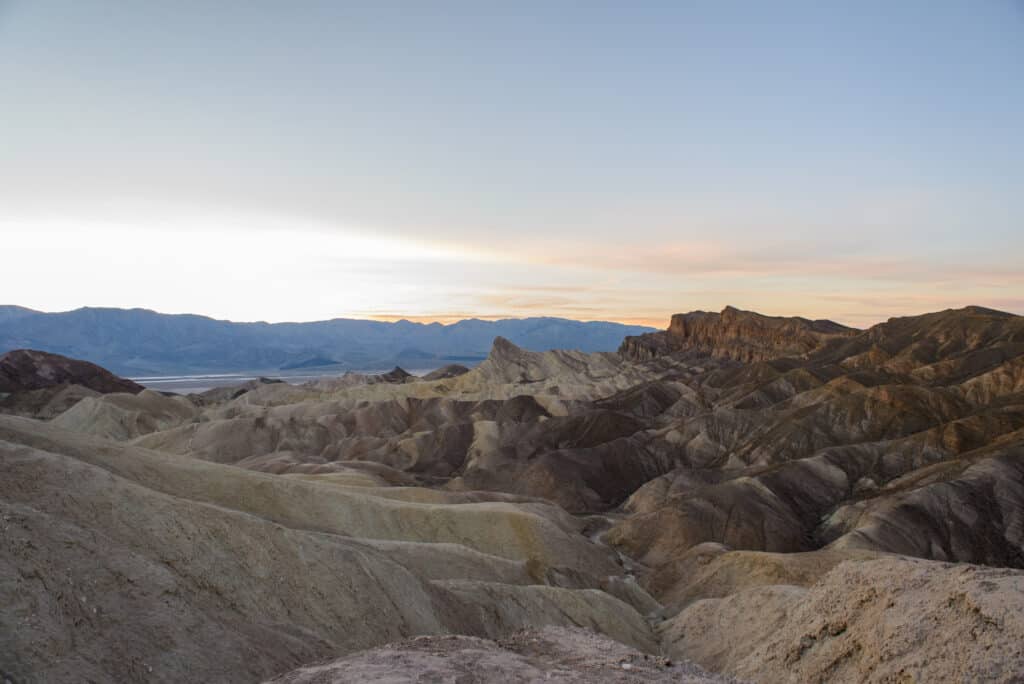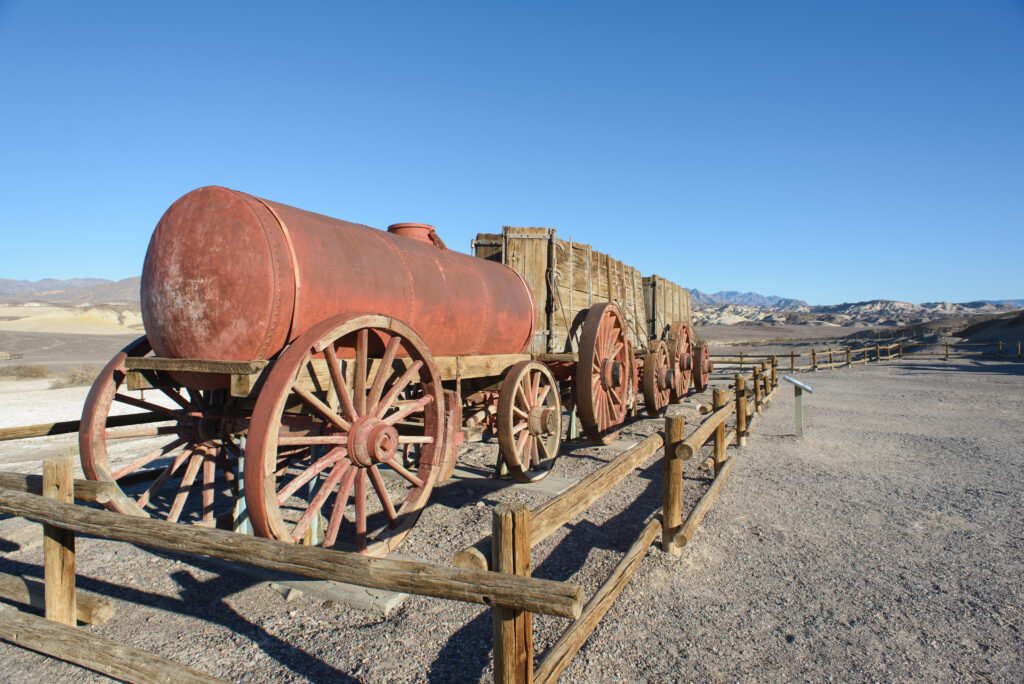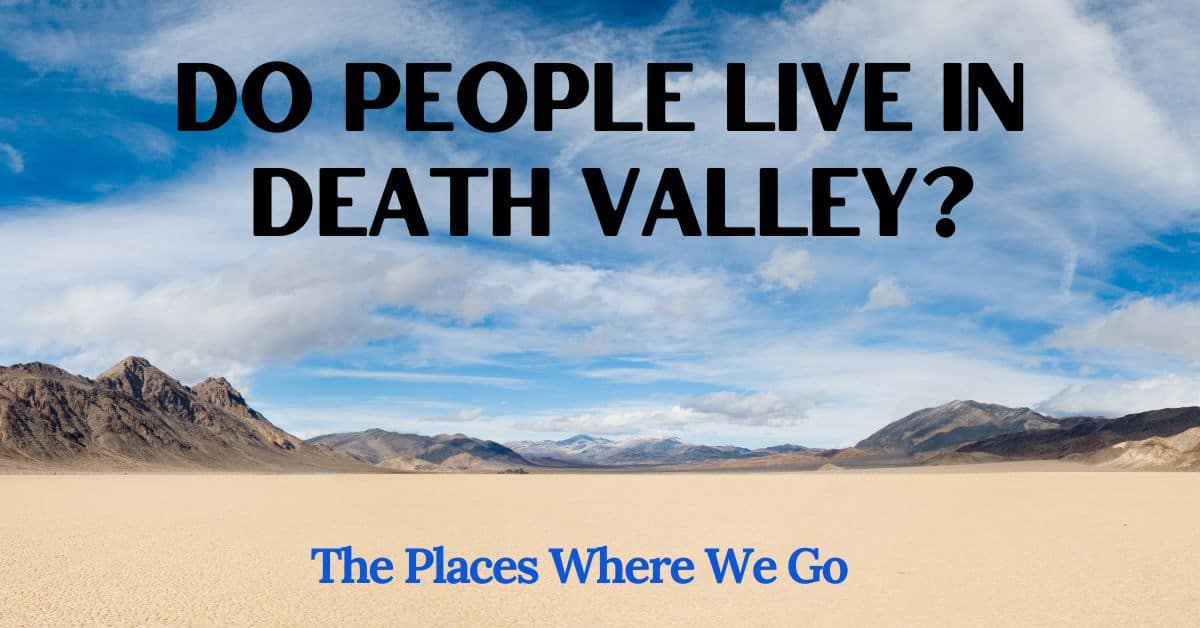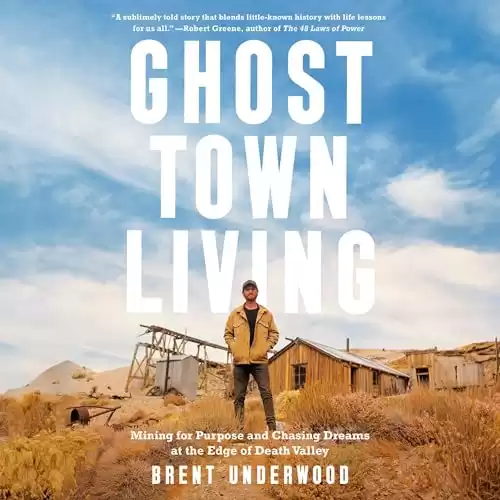Do People Live in Death Valley? Survival In The Hottest Place On Earth
Do People Live in Death Valley – An Introduction
In our travels to Death Valley, we’ve experienced the vast, remote landscape where there is no human life for miles and miles. In this desolation, we ask ourselves, “Do people live in Death Valley?” And the short answer is yes! Nearly one thousand people are living in Death Valley, California.
Death Valley offers its inhabitants an unforgiving yet unique landscape. With temperatures reaching as high as 134°F in the summer, it takes a particular person to survive and thrive in this remote desert environment.
Most who have chosen to make Death Valley their home do not do so year-round. Some live in the area as season inhabitants, while a few make their full-time home in Death Valley. These unique individuals have chosen to live in some of North America’s most extreme climates.
Death Valley fascinates us with every visit. Read on to learn about life in Death Valley and what it takes to survive in one of Earth’s hottest and driest places.

Disclaimer
The Places Where We Go contains affiliate links and is a member of the Amazon Services LLC Associates Program. As an Amazon Associate, we earn from qualifying purchases at no extra cost to you when you purchase using one of these Amazon links. Read our disclaimer and privacy policy for more information.
Death Valley Population
It is the Timbisha Shoshone that claims the longest legacy in Death Valley.
New residents came to Death Valley in the 19th century with the discovery of borax. As borax production increased, 1883-1889 saw a short influx of a new type of resident. Nearby towns emerged to support the mining operations but became ghost towns quickly as the mines didn’t survive for many years.
But does anyone live in Death Valley today? The answer is not many, but some people do make their home in this difficult environment.
We go to the Census to learn how many people live in Death Valley. The Death Valley population is reported at 1,124 people at censusreporter.org
Most Death Valley residents are seasonal campers, hunters, or miners. However, there are also a small number of permanent residents who live in Death Valley year-round.
Most people who set foot in Death Valley are tourists. The area attracts people from all over the world. Yet they stay for a few days to experience the magnificent national park, then move on, leaving just the few hundred full-timers as the constant presence in Death Valley.
What’s it like to live in Death Valley?
Living in Death Valley is an experience that few people get to experience. From the extreme temperatures to the unique landscape, it provides an experience, unlike any other place on earth.
The summer months bring extreme heat, often reaching well above 100°F (38°C). The highest recorded Death Valley temperature ever was 134 degrees Fahrenheit!
Apart from the extreme temperatures, living in Death Valley has its unique beauty. From the rugged mountains to the vast desert terrain, there’s beauty to behold in this magnificent western desert.
Death Valley residents are connected to its environment but are also content with this desolate landscape’s isolation. It takes a person comfortable with solitude to live in the solitude of this desert – a rarity in today’s world of constant communication.
Many folks ask the question, “What is life like in Death Valley?” Life in Death Valley is ideally suited for people who want to leave the rest of the world behind.
Map via Google Maps
The harsh climate of Death Valley
Having one of the hottest places on earth, the climate in Death Valley is incredibly harsh. And living in such a place is not for everyone.
And where is Death Valley? Death Valley is located in the northern Mojave Desert, bordering the Great Basin Desert in Eastern California. The national park sits between two major mountain ranges: the Amargosa Range on the east, and to the west you have the Panamint Range.
What makes the climate so harsh is the lack of water and shade. There is very little vegetation and few water sources, making it difficult for people and animals to survive in the area.
The rocky terrain and dry air also contribute to the harsh climate, with temperatures often staying well above 100°F (38°C) for long periods. Death Valley is also known for its strong winds, which can make for an uncomfortable living experience.
Death Valley’s climate is not suitable for many forms of life. That said, those who choose to make Death Valley their home have usually adapted and prepared for the extreme temperatures and conditions of living in such a demanding environment. During periods of intense heat, residents stay inside their dwellings and use air conditioning systems.
What Indian tribe lives in Death Valley?
The Timbisha Shoshone are the indigenous people of what is now known as Death Valley. The tribe has existed for thousands of years and continues to inhabit the area today.
These people have adapted to the harsh environment of Death Valley and continue to live a traditional lifestyle, which includes hunting and gathering food. They are actively involved in protecting and preserving their ancestral lands and protecting the tribe’s heritage and culture.
The Timbisha Shoshone symbolizes the tenacity and resilience of the human spirit. Despite living in what can be one of the harshest climates on earth, they continue to survive and thrive in this remote desert environment. There are about 50-60 living members of the tribe who live in the Death Valley area today. Members work for resorts and local organizations.
Where do people who work in Death Valley live?
A number of people who live and work in Death Valley are transient workers who come for the summer season to take advantage of the growing tourism industry. These individuals typically stay in one of the local resorts or campgrounds where they can access amenities such as air conditioning, running water, and other forms of entertainment.
However, there are also a small number of permanent residents who live in Death Valley year-round. These individuals typically work for the area’s primary employer, The National Park Service. They can live in nearby towns such as Beatty, where they can access services and amenities that make a living in Death Valley more comfortable.

How much does it cost to live in Death Valley?
The cost of living in Death Valley is higher than the national average. For ZIP Code 92328, the cost of living index comes in at 112.7, making Death Valley 12.7% higher than the national average. (Source: Bestplaces.net)
However, specific basic amenities are expensive. As transporting goods to the area is difficult and dangerous, fuel and food can be costly. Also, there isn’t access to shopping centers and supermarkets inside Death Valley, so travel to outside communities is part of the cost of living.
Death Valley living may be a bit more expensive than in some rural areas due to its remote location and the cost of traveling there. However, it is still much more affordable than most major cities, and those who choose to call Death Valley home can find a cost of living that is quite reasonable.
Some workers live in trailer homes. Managers and supervisors might receive free room and board privileges. As there are almost no social distractions found in Death Valley, saving money is more accessible than in places with many activities.
What do people in Death Valley do for entertainment?
There are limited distractions in Death Valley. There are no bowling alleys, shopping centers, or supermarkets. Residents frequently must travel at least one hour to reach essential services and amenities. The closest large city, Las Vegas, is two hours away.
This small population of this community stays tightly knit. Living here is suited for people who are comfortable living alone and aren’t bothered by an environment that could cause severe boredom for many.
Popular outdoor activities include hiking during the day and watching the stars at night. And indoors, there’s always television or surfing the internet.
What is the temperature like in Death Valley?
The temperature in Death Valley can vary drastically, ranging from extremely hot to extreme cold. During the summer months, temperatures can reach up to 134 degrees Fahrenheit, and temperatures can dip as low as 15 degrees Fahrenheit during the winter months. The average high temperature is around 95-105 degrees, while the average low temperature is about 55-65.
Death Valley weather is incredibly hot and dry regardless of the time of year. It’s essential to take extra care when visiting the area, as dehydration can be severe, and heat exhaustion is also possible. Be sure to stay hydrated and dress appropriately for the weather if you plan to spend any time in Death Valley.
We’re not fans ourselves of extreme heat, so our favorite time to visit Death Valley is during the winter. We also had an incredible time visiting during the spring for our most recent visit when the wild flowers were blooming in abundance.
Is it dangerous to live in Death Valley?
Given its harsh climate, yes, Death Valley can be a dangerous place to live. Extreme temperatures have played a part in the deaths of people. Winter storms have also brought dangerous flooding to the area that can lead to loss of life. There is also danger from animal life, including scorpions and snakes.
When traveling to remote areas within Death Valley, it is prudent to carry a satellite phone as cell signals are not always guaranteed. And extra water is a must if driving off the main road or hiking into the backcountry.
People die here every year because of the heat. Sometimes it’ll be a tourist passing out in the park, but more often than not it’s some adventurous type who thought they would go for a long walk in the middle of summer. Then there’s a massive search effort that has to happen to recover the body later on. There was a case with a German family who went missing, and there was a manhunt to find their bodies. Heat and dehydration kills.
Patrick Donnelly – iNews UK
Can you drink the water in Death Valley?
The Furnace Creek Community water supply is collected from three wells. Tap water can often exceed 100 degrees as the area’s intense heat penetrates through the ground to underground pipes. The water is considered moderately mineralized and high silica water.
If you plan to stay in the park for longer than a day, you can purchase potable water from one of the local stores or resorts. Alternatively, you can also use reverse osmosis systems to filter the water and make it safe to drink. It is always best to check with a local health provider before drinking any water from Death Valley, however, as the park can contain other pollutants that can be harmful if consumed.
Does Death Valley have electricity?
Yes, Death Valley does have electricity. Electricity is supplied by a few power plants, such as the NV Energy Las Vegas Electric Power Plant and the California Edison White Bluffs Generating Plant. These plants provide power to many resorts, businesses, and homes in the region. While most of these facilities are powered by traditional sources, some solar power plants are also in the area.
Power is also available to campers and visitors in Death Valley National Park. With the help of a few power plants and solar facilities, visitors to the area can enjoy all the comforts of electricity while soaking up the natural beauty of Death Valley.
Does Death Valley have cell service?
Yes, Death Valley does have cell service. Three major cellular providers provide coverage in the park: AT&T, Verizon, and T-Mobile. All three of these companies offer decent coverage within the park boundaries. However, signal strength can vary depending on where you are located. If you plan to be in more remote areas of the park, it’s always a good idea to have a backup plan in case cellular service is unreliable or nonexistent.
Additionally, many visitors bring a generator for their RV or camper to ensure they have access to power if needed. This can be especially useful for charging phones and other devices during your stay in Death Valley. Just be sure to check with the National Park Service for any regulations or guidelines regarding generator use.
Are there jobs in Death Valley?
Yes, there are a variety of jobs available in Death Valley. There are various resorts and businesses that are located throughout the park, and these often have openings for both full-time and part-time positions.
Additionally, the National Park Service regularly hires seasonal workers to help with maintenance and other projects within the park. Jobs such as interpretive rangers, campground hosts, and backcountry guides are all available for those seeking employment in Death Valley.
Many freelance opportunities are also available to photographers, writers, and other creative professionals looking to explore the area.
Employment opportunities are found via job postings at the local resorts and businesses and on the National Park Service jobs website.
Are there schools in Death Valley?
No, there are no schools in Death Valley. The area is too remote and isolated to sustain a school system or other educational institutions. Most children living in the region are home-schooled or travel long distances to attend public schools outside the park boundaries. Additionally, due to the harsh desert environment, most people who live in Death Valley are seasonal visitors, so having a school in the area would not be practical.
However, several universities located nearby are within easy driving distance from Death Valley. These include the University of Nevada Reno, California State University Bakersfield, and Arizona State University Yuma.
Does Death Valley have police and fire departments?
No, Death Valley does not have a police department. The National Park Service provides law enforcement and emergency services for the area, with assistance from local law enforcement and fire agencies when needed. Visitors are encouraged to dial 911 for help if an emergency occurs in the park.
Although there is no dedicated police department in Death Valley, the National Park Service has a ranger station staffed with personnel trained and equipped to respond quickly to any situation. Additionally, the California Highway Patrol is responsible for patrolling highways and roads in and around Death Valley. In an emergency, they can be reached at 911 or by calling their dispatch center directly at (800) 835-5247.
The Death Valley Fire Department provides community fire protection and emergency response services. The department also responds to medical emergencies, hazardous materials incidents, rescue calls, and motor vehicle or other accidents.
Death Valley National Park Fire and Rescue: (760) 786-3200
What are the demographics in Death Valley?
As of 2022, the Death Valley CCD reports the following data:
Population of Death Valley: 1,124
Median age: 45.7
Sex: Males (55%), Females (45%)
Race & Ethnicity: White (63%), Hispanic (20%), Other (17%)
Homeownership rate: 79%
Median household income: $55,417
Households: 581
Persons per household: 1.5
Marital status: 38% married
Education: High school or higher (95%), Bachelor’s degree or higher (43.5%)
Data from censusreporter.org for BG 1, Tract 8, Inyo, CA
Overall, Death Valley is a sparsely populated area, with most residents being over the age of 45 with average educational backgrounds and incomes. Many people living in the area are seasonal visitors or retirees. This makes it even more important to be familiar with park regulations and take precautions when visiting Death Valley. Just be sure to follow all instructions and exercise caution when visiting this unique area.
How Big is Death Valley?
Death Valley is an expansive national park that is the largest in the contiguous United States. It covers a vast area of over 3.4 million acres and includes a range of environments, from salt flats and sand dunes to mountains and canyons. This area is larger than the states of Delaware and Rhode Island combined and is nearly as big as the entire territory of Puerto Rico.
Why Do People Live in Death Valley?
People live in Death Valley for various reasons despite its extreme heat, which can reach up to 134 degrees Fahrenheit. Some are transient workers who come for the tourism season, while others are permanent residents, often employed by the National Park Service or local resorts.
Living there is relatively affordable, although certain costs like food and fuel can be higher due to the remote location. Residents tend to be tightly-knit, resourceful, and have a strong connection to nature, often enjoying activities like hiking and stargazing. Modern amenities such as electricity, water, cell service, and internet are available, helping to make life in this harsh environment manageable.
It’s a place for those who seek isolation from the noise of the world and who are comfortable living in solitude, in close communion with nature.
Adjusting to the extreme conditions takes time, but residents report that their bodies eventually acclimate to the high temperatures, and they learn to live with the realities of their environment, taking precautions against the risks. They create lives that embrace the uniqueness of Death Valley, finding it a home despite—or perhaps because of—its challenges.
Do People Live In Death Valley – Conclusion
Yes, people do live in Death Valley! Although it is an extremely harsh and unforgiving environment, a few hardy souls still have made this desert oasis their home. However, most of the population consists of seasonal visitors or retirees seeking solitude only in such an isolated place.
Those looking to explore what Death Valley offers should familiarize themselves with the local population and park regulations. With a bit of preparation and knowledge, visitors can have an amazing experience in what is undoubtedly one of the unique landscapes on Earth.
Get Our Free Death Valley Packing Checklist
Read more about living in Death Valley
Read Our Other Posts About Death Valley
Where To Stay In Death Valley – 18 Top Places
One Day Death Valley Itinerary – 9 Awesome Stops
Death Valley Packing List – Don’t Leave Home Without These Items
#deathvalley


